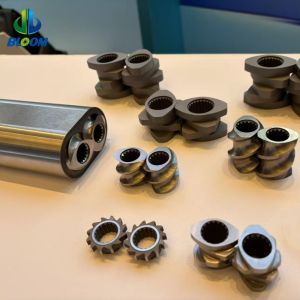
Add to Cart
For HFFR compounding, the extruder's screw elements, barrel, and liners must be constructed from highly wear-resistant materials (like bi-metallic alloys or Tungsten Carbide coatings) to withstand the extreme abrasion from mineral flame retardants. Their design also focuses on efficient mixing and gentle heat control to achieve a uniform compound while maintaining polymer integrity.
1. Screw Elements
Function: They are the core components mounted on the screw shafts inside the barrel. Their primary role is to convey, melt, mix, and pump the plastic material.
Key Features for HFFR:
Material: Typically made from wear-resistant alloys (e.g., bi-metallic). HFFR compounds often contain abrasive mineral fillers like magnesium hydroxide (MDH) or aluminum hydroxide (ATH), which cause severe wear.
Surface Treatment: Often coated with hard, wear-resistant coatings like Tungsten Carbide (WC) or applied with specific hardening techniques (e.g., nitriding) to significantly extend service life.
Design: Special mixing elements (e.g., kneading blocks, mixing pins) are crucial to ensure homogeneous dispersion of the flame retardant fillers within the polymer matrix without degrading the base resin.
2. Barrel
Function: The barrel houses the rotating screws and forms the enclosed chamber where plasticization and mixing occur under high temperature and pressure.
Key Features for HFFR:
Liner/Bushing: The inner surface of the barrel is typically lined with a removable liner or bushing. This is the part that directly contacts the material and bears the brunt of the wear.
Material: Like the screws, these liners are made from extremely wear-resistant materials. A common construction is a bi-metallic barrel, where the outer shell is strong steel, and the inner liner is a centrifugally cast wear-resistant alloy (e.g., Xaloy, Reiloy).
Cooling: Often equipped with efficient cooling channels to manage the heat generated by the high shear stresses and filler friction, preventing material degradation.
3. Liners / Bushings
Function: These are the replaceable inner sleeves of the barrel. They protect the main barrel body from wear and can be replaced, which is more economical than replacing the entire barrel.
Key Features for HFFR:
They are specifically designed to be the primary wear component.
Made from the hardest available materials to resist the abrasive nature of HFFR fills. Common choices include advanced bi-metallic alloys or liners with Tungsten Carbide coatings.
Their replaceability is a key maintenance feature for extruders processing highly abrasive materials.




